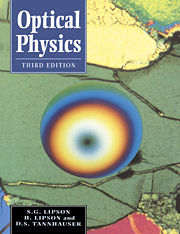Book contents
- Frontmatter
- Contents
- Preface to the third edition
- Preface to the second edition
- Preface to the first edition
- 1 History of ideas
- 2 Waves
- 3 Geometrical optics
- 4 Fourier theory
- 5 Electromagnetic waves
- 6 Polarization and anisotropic media
- 7 Diffraction
- 8 Fraunhofer diffraction and interference
- 9 Interferometry
- 10 Optical waveguides and modulated media
- 11 Coherence
- 12 Image formation
- 13 The classical theory of dispersion
- 14 Quantum optics and lasers
- 15 Problems
- Appendix 1 Bessel functions in wave optics
- Appendix 2 Lecture demonstrations in Fourier optics
- Bibliography
- Index
9 - Interferometry
- Frontmatter
- Contents
- Preface to the third edition
- Preface to the second edition
- Preface to the first edition
- 1 History of ideas
- 2 Waves
- 3 Geometrical optics
- 4 Fourier theory
- 5 Electromagnetic waves
- 6 Polarization and anisotropic media
- 7 Diffraction
- 8 Fraunhofer diffraction and interference
- 9 Interferometry
- 10 Optical waveguides and modulated media
- 11 Coherence
- 12 Image formation
- 13 The classical theory of dispersion
- 14 Quantum optics and lasers
- 15 Problems
- Appendix 1 Bessel functions in wave optics
- Appendix 2 Lecture demonstrations in Fourier optics
- Bibliography
- Index
Summary
Introduction
In Chapter 8 we discussed the theory of Fraunhofer diffraction and interference emphasizing in particular the relevance of Fourier transforms. In this chapter we shall describe the applications of interference to measurement; this is called interferometry. Some of the most accurate dimensional measurements are made by interferometric means, particularly using waves of different types – electromagnetic, matter, acoustic etc. The variety of techniques is enormous, and we shall limit ourselves in this chapter to a discussion of several distinctly different interferometric principles, without any intention of describing the variety of instruments or methods within the classes. There are several monographs on interferometry which discuss practical aspects in greater detail, for example Tolansky (1973), Steel (1983) and Hariharan (1985).
The discovery of interference effects by Young (§1.2.4) enabled him to make the first interferometric measurement, a determination of the wavelength of light. Even this primitive system, a pair of slits illuminated by a common point source, can be surprisingly accurate, as we shall see in §9.1.1. In general interference is possible between waves of any non-zero degree of mutual coherence (§11.4), including different sources (light beats), but for the purposes of this chapter we shall simply assume that waves are either completely coherent (in which case they can interfere) or incoherent (in which case no interference effects occur between them). In the case of complete coherence, there is a fixed phase relationship between the waves, and interference effects are observed that are stationary in time, and can therefore be observed with primitive instruments such as the eye or photography.
- Type
- Chapter
- Information
- Optical Physics , pp. 220 - 262Publisher: Cambridge University PressPrint publication year: 1995
- 1
- Cited by



